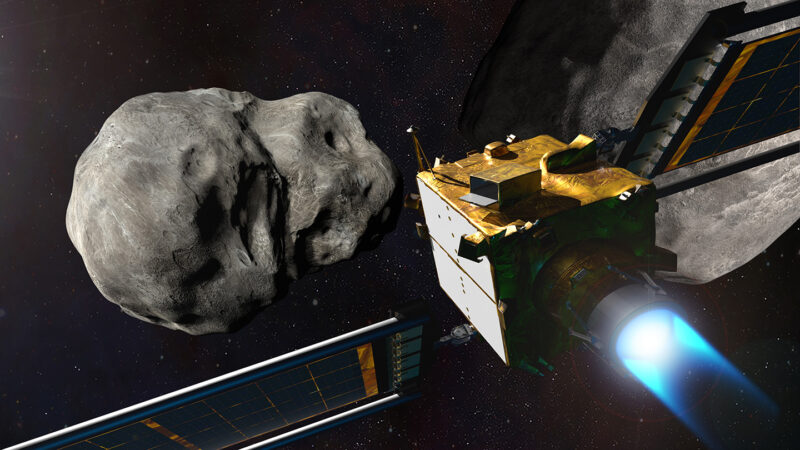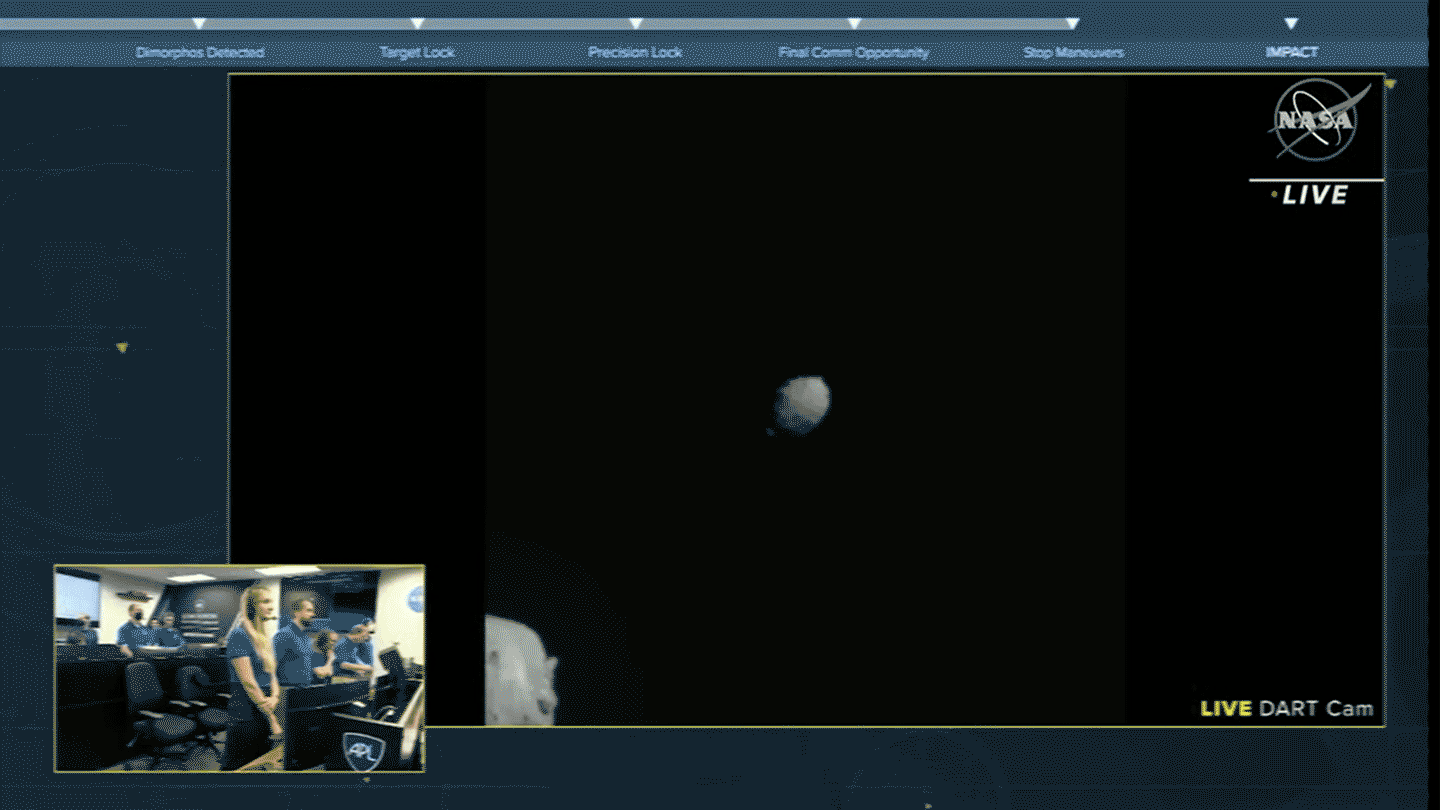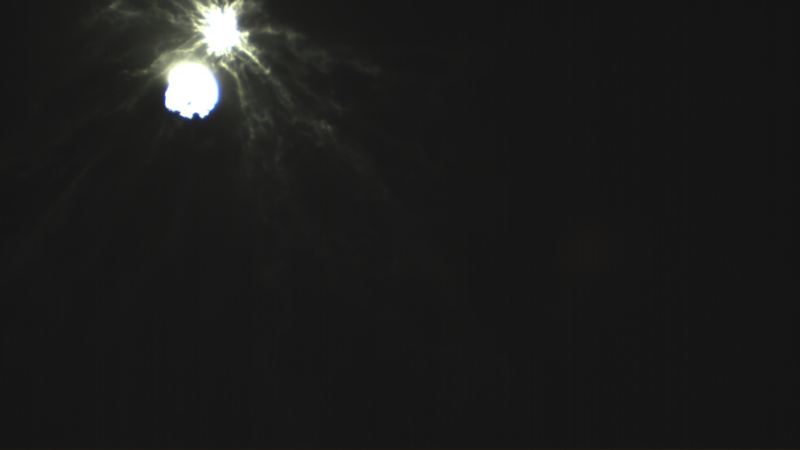Mission control rooms rarely celebrate crash landings. But the collision of NASA’s DART spacecraft with an asteroid was a smashing success.
At about 7:15 p.m. EDT on September 26, the spacecraft hurtled into Dimorphos, an asteroid moonlet orbiting a larger space rock named Didymos. The mission’s goal was to bump Dimorphos slightly closer to its parent asteroid, shortening its 12-hour orbit around Didymos by several minutes.
The Double Asteroid Redirection Test, or DART, is the world’s first attempt to change an asteroid’s motion by ramming a space probe into it (SN: 6/30/20). Neither Dimorphos nor Didymos poses a threat to Earth. But seeing how well DART’s maneuver worked will reveal how easy it is to tamper with an asteroid’s trajectory — a strategy that could protect the planet if a large asteroid is ever discovered on a collision course with Earth.
“We don’t know of any large asteroids that would be considered a threat to Earth that are coming any time in the next century,” says DART team member Angela Stickle, a planetary scientist at the Johns Hopkins University Applied Physics Laboratory in Laurel, Md. “The reason that we are doing something like DART is because there are asteroids that we haven’t discovered yet.”
 NASA’s DART spacecraft (illustrated) just crashed into the asteroid moonlet Dimorphos on purpose in the world’s first test of a strategy for planetary defense.Johns Hopkins APL/NASA
NASA’s DART spacecraft (illustrated) just crashed into the asteroid moonlet Dimorphos on purpose in the world’s first test of a strategy for planetary defense.Johns Hopkins APL/NASA
Astronomers have spotted almost all the kilometer-size asteroids in the solar system that could end civilization if they hit Earth, says Jessica Sunshine, a planetary scientist at the University of Maryland in College Park who’s also on the DART team. But when it comes to space rocks around 150 meters wide, like Dimorphos, “we only know where about 40 percent of those are,” Sunshine says. “And that is something that, if it did hit, would certainly take out a city.”
Dimorphos is a safe asteroid to give an experimental nudge, says Mark Boslough, a physicist at Los Alamos National Laboratory in New Mexico who has studied planetary protection but is not involved in DART. “It’s not on a collision course” with Earth, he says, and DART “can’t hit it hard enough to put it on a collision course.” The DART spacecraft weighs only as much as a couple of vending machines, whereas Dimorphos is thought to be nearly as hefty as Egypt’s Great Pyramid of Giza.
After a 10-month voyage, DART met up with Didymos and Dimorphos near their closest approach to Earth, about 11 million kilometers away. Up until the very end of its journey, DART could see only the larger asteroid, Didymos. But about an hour before impact, DART spotted Dimorphos in its field of view. Using its onboard camera, the spacecraft steered itself toward the asteroid moonlet and slammed into it at some 6.1 kilometers per second, or nearly 14,000 miles per hour.
 After traveling about 11 million kilometers, NASA’s DART spacecraft closed in on its target: the asteroid moonlet Dimorphos. This image of the space rock was taken by DART just seconds before the spacecraft smashed into it.
After traveling about 11 million kilometers, NASA’s DART spacecraft closed in on its target: the asteroid moonlet Dimorphos. This image of the space rock was taken by DART just seconds before the spacecraft smashed into it.
NASA
DART’s camera feed went dark after impact. But another probe nearby caught the collision on camera. The Light Italian CubeSat for Imaging of Asteroids rode to Dimorphos aboard DART but detached a couple of weeks before impact to watch the event from a safe distance. Its mission was to whiz past Dimorphos about three minutes after DART’s impact to snap pictures of the crash site and the resulting plume of asteroid debris launched into space. The probe’s first images of DART’s demise were released September 27.
 This image, which shows the plume of debris launched by DART’s collision with Dimorphos, was taken by the Light Italian CubeSat for Imaging of Asteroids from about 57 kilometers away.
This image, which shows the plume of debris launched by DART’s collision with Dimorphos, was taken by the Light Italian CubeSat for Imaging of Asteroids from about 57 kilometers away.
ASI, NASA
“I was absolutely elated, especially as we saw the camera getting closer and just realizing all the science that we’re going to learn,” said Pam Melroy, NASA Deputy Administrator, after the impact. “But the best part was seeing, at the end, that there was no question there was going to be an impact, and to see the team overjoyed with their success.”
DART’s impact is expected to shove Dimorphos into a closer, shorter orbit around Didymos. Telescopes on Earth can clock the timing of that orbit by watching how the amount of light from the double asteroid system changes as Dimorphos passes in front of and behind Didymos.
This animation shows how DART’s impact on Dimorphos will affect the space rock’s orbit around its larger parent asteroid, Didymos. DART should shove Dimorphos into a slightly tighter, shorter orbit.
“It’s really a beautifully conceived experiment,” Boslough says. In the coming weeks, dozens of telescopes across every continent will watch Dimorphos to see how much DART changed its orbit. The Hubble and James Webb space telescopes may also get images.

Sign Up For the Latest from Science News
Headlines and summaries of the latest Science News articles, delivered to your inbox
Client key* E-mail Address* Go
Thank you for signing up!
There was a problem signing you up.
“It’ll be really interesting to see what comes out,” says Amy Mainzer, a planetary scientist at the University of Arizona in Tucson who is not involved in DART. “Asteroids have a way of surprising us,” she says, because it’s hard to know a space rock’s precise chemical makeup and internal structure based on observations from Earth. So Dimorphos’ motion post-impact may not exactly match researchers’ expectations.
The DART team will compare data on Dimorphos’ new orbit with their computer simulations to see how close those models were to predicting the asteroid’s actual behavior and tweak them accordingly. “If we can get our models to reproduce what actually happened, then you can use those models to [plan for] other scenarios that might show up in the future” — like the discovery of a real killer asteroid, says DART team member Wendy Caldwell, a mathematician and planetary scientist at Los Alamos National Laboratory.
“No matter what happens,” she says, “we will get information that is valuable to the scientific community and to the planetary defense community.”

